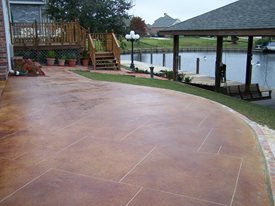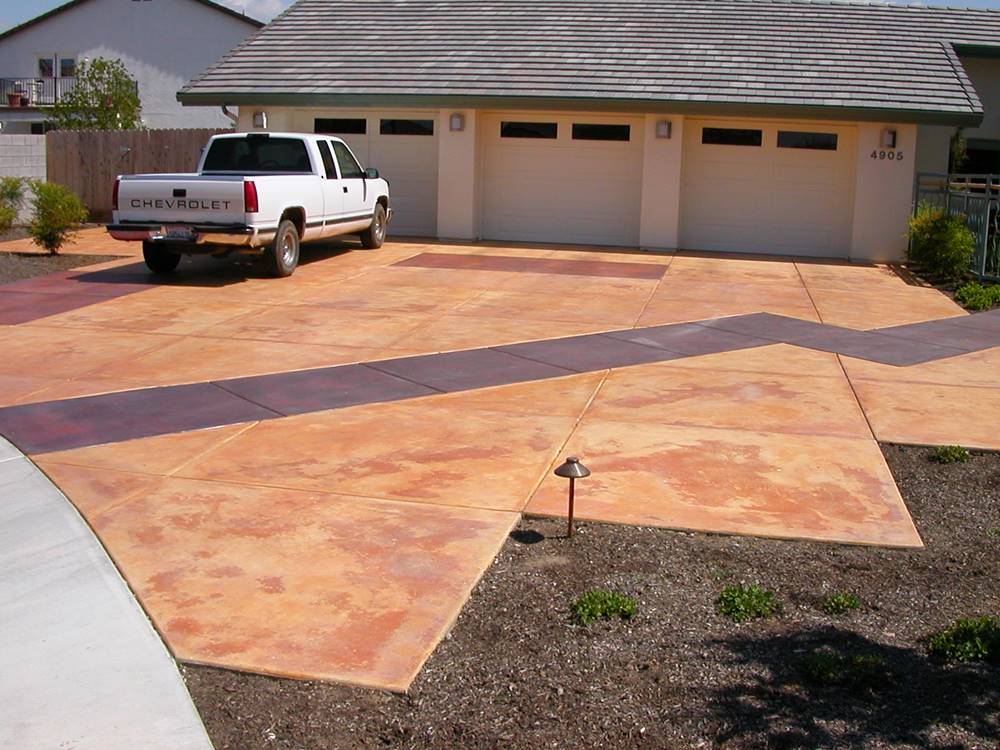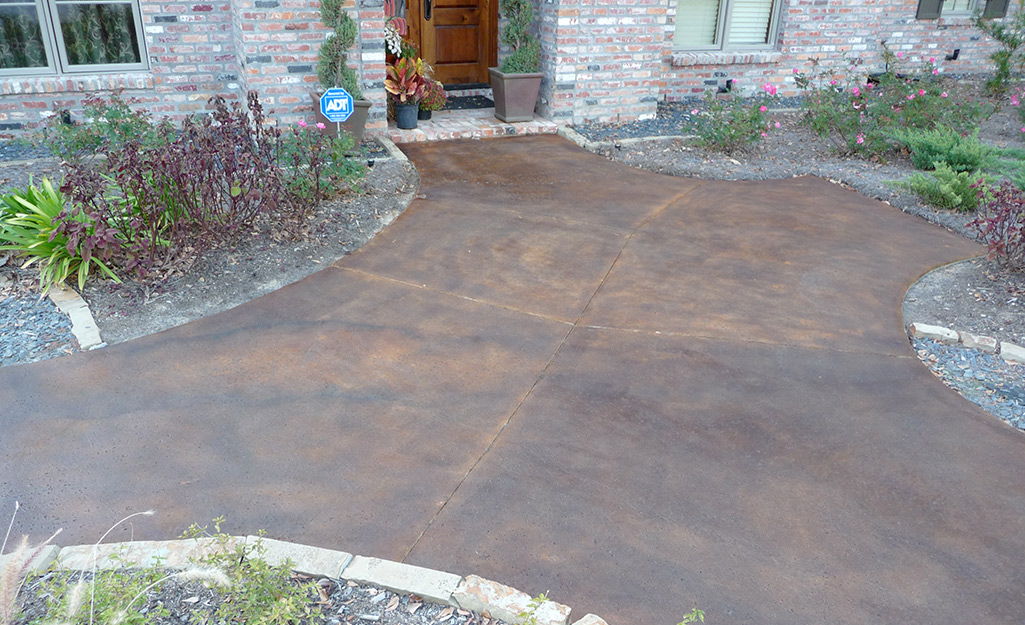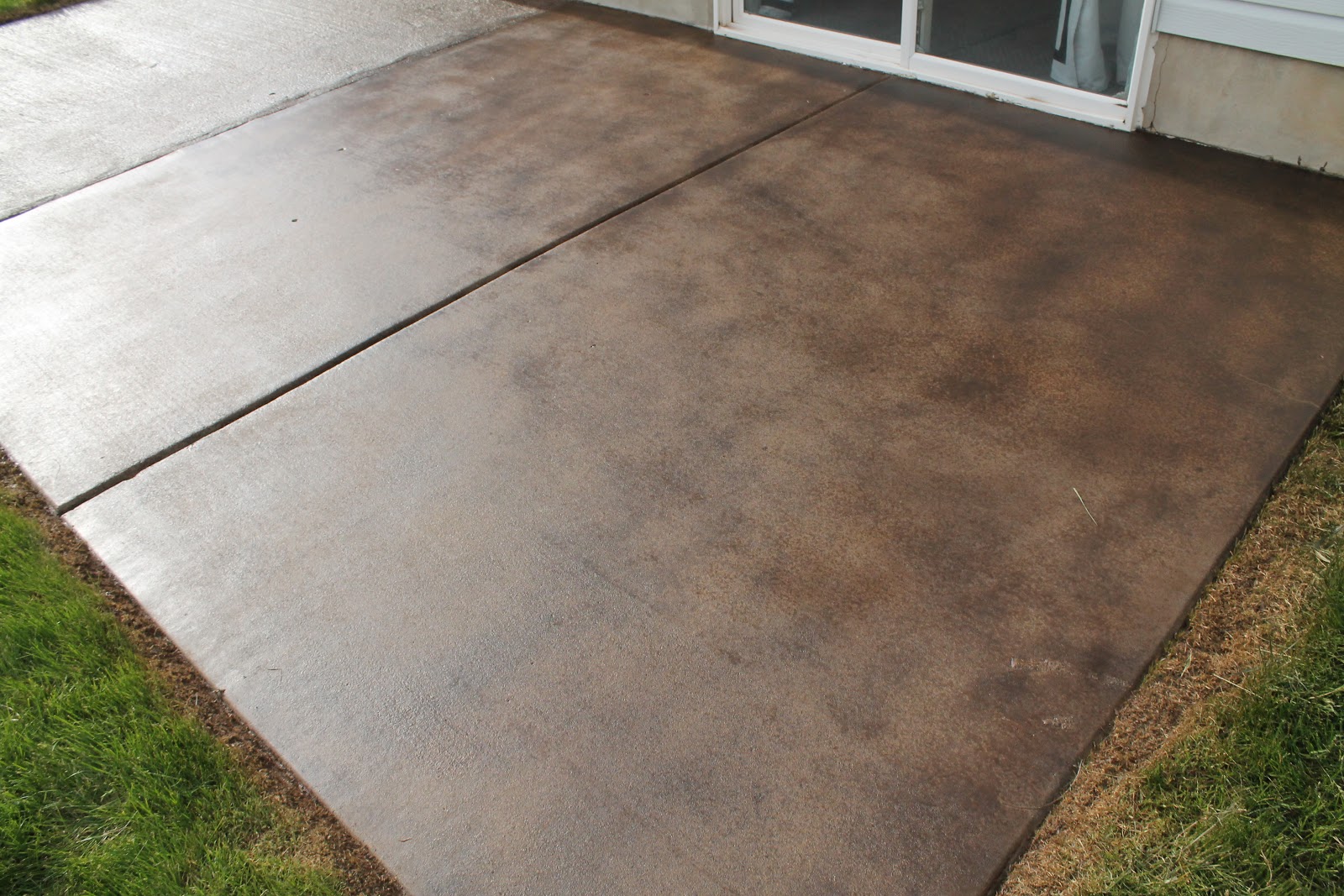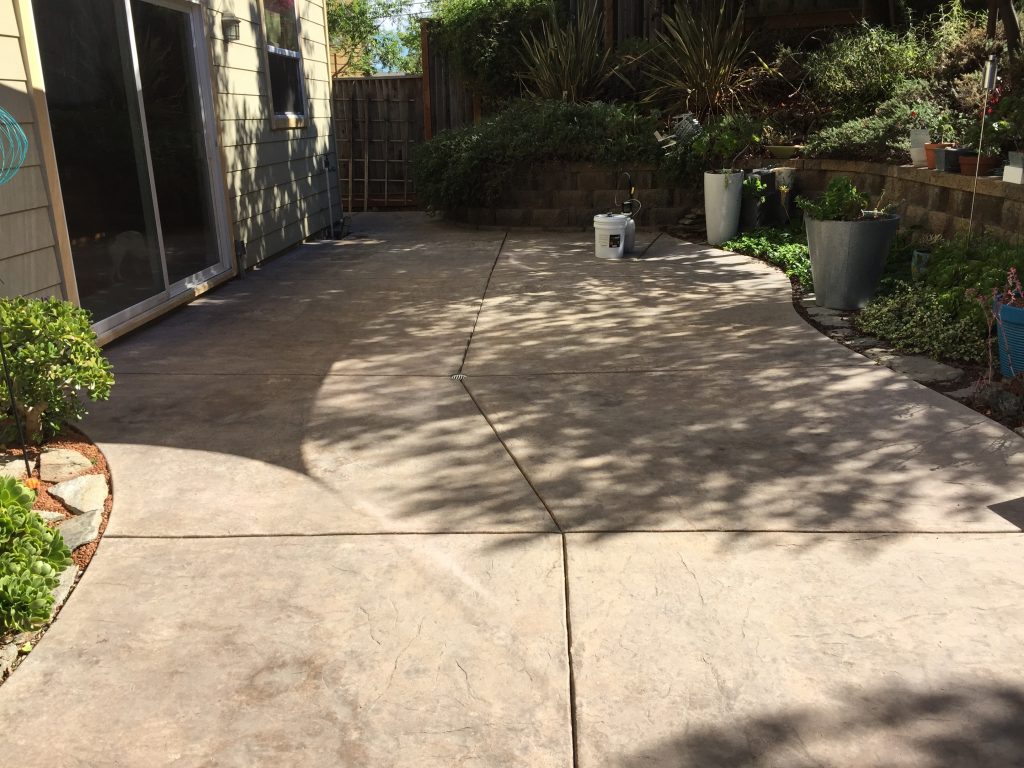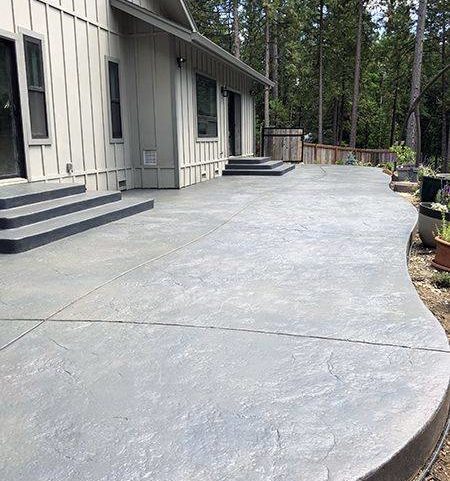Preparing The Concrete Surface for Staining
Before you can begin staining your outdoor concrete floors, it’s crucial to properly prepare the surface to ensure optimal results. Proper preparation not only helps the stain adhere better but also ensures a more uniform and attractive finish. Here are some essential steps to prepare the concrete surface for staining:
- Clean the Surface: Start by thoroughly cleaning the concrete surface to remove any dirt, debris, oil, grease, or other contaminants. Use a pressure washer or hose with a high-pressure nozzle to remove stubborn stains and dirt. For tougher stains, you may need to use a concrete cleaner or degreaser and scrub the surface with a stiff brush.
- Repair Cracks and Damage: Inspect the concrete surface for any cracks, chips, or other damage, and repair them as needed. Use a concrete patching compound to fill in cracks and holes, and smooth the surface with a trowel or putty knife. Allow the patching compound to dry completely before proceeding to the next step.
- Etch the Surface: Etching the concrete surface helps open up the pores and allows the stain to penetrate more effectively. Use a concrete etching solution or muriatic acid diluted with water according to the manufacturer’s instructions. Apply the etching solution evenly to the surface using a sprayer or mop, and scrub the surface with a stiff brush or broom. Rinse the surface thoroughly with clean water and allow it to dry completely.
- Test for Porosity: Before applying the stain, it’s important to test the porosity of the concrete surface to ensure proper adhesion and color penetration. Sprinkle water onto the surface and observe how quickly it absorbs. If the water beads up or sits on the surface, the concrete may need to be re-etched. If the water is absorbed quickly, the surface is ready for staining.
- Protect Surrounding Areas: Finally, take steps to protect surrounding areas from overspray or drips during the staining process. Use plastic drop cloths or masking tape and paper to cover nearby walls, plants, and other surfaces. This will help prevent accidental staining and make cleanup easier.

Choosing the Right Stain for Outdoor Concrete Floors
Choosing the right stain for your outdoor concrete floors is essential to achieving the desired look and durability. With various options available on the market, it’s important to consider factors such as color, opacity, durability, and compatibility with the concrete surface. Here are some key points to keep in mind when selecting a stain for outdoor concrete floors:
Acid Stains: Acid stains are a popular choice for outdoor concrete floors due to their unique, mottled appearance and durability. Acid stains penetrate the concrete surface and react chemically with the minerals to create rich, variegated colors that mimic natural stone or marble. They are available in a wide range of earthy tones, including browns, greens, blues, and reds, and can be customized to achieve the desired intensity and depth of color.
Water-Based Stains: Water-based stains offer a wider range of color options and are easier to work with than acid stains. They are available in a variety of vibrant hues, including blues, greens, yellows, and oranges, and can be mixed and matched to create custom colors. Water-based stains penetrate the concrete surface and dry quickly, making them ideal for outdoor applications where time is of the essence.
Semi-Transparent Stains: Semi-transparent stains are a versatile option for outdoor concrete floors, offering both color and protection without completely obscuring the natural beauty of the concrete. These stains penetrate the surface and enhance the natural variations in color and texture, creating a subtle, translucent finish that allows the underlying concrete to show through.
Solid Color Stains: Solid color stains provide maximum color coverage and durability, making them ideal for outdoor concrete floors that are heavily trafficked or exposed to harsh weather conditions. These stains contain pigments that adhere to the surface of the concrete, creating an opaque, uniform finish that hides imperfections and protects against UV damage, moisture, and staining.
Considerations for Climate: When choosing a stain for outdoor concrete floors, it’s important to consider the climate and weather conditions in your area. Opt for stains that are specifically formulated to withstand exposure to sunlight, rain, snow, and temperature fluctuations without fading, peeling, or discoloring. Consult with a professional or the manufacturer for recommendations on the best stain for your particular climate and environment.
Applying the Stain to Outdoor Concrete Floors
Once you’ve selected the right stain for your outdoor concrete floors and properly prepared the surface, it’s time to apply the stain. Proper application is crucial to achieving a uniform, attractive finish that enhances the beauty and durability of the concrete. Here are some essential steps to follow when applying stain to outdoor concrete floors:
Test the Stain: Before applying the stain to the entire surface, it’s important to test it in an inconspicuous area to ensure that you achieve the desired color and effect. Apply a small amount of stain to the test area and allow it to dry completely. Evaluate the color, opacity, and finish to determine if any adjustments are needed before proceeding.
Prepare the Stain: If using an acid stain, mix the stain according to the manufacturer’s instructions and transfer it to a pump sprayer or sprayer bottle for easy application. If using a water-based or solid color stain, simply shake or stir the stain thoroughly before use. Ensure that the stain is well mixed and free of any lumps or clumps before applying.
Apply the Stain: Begin by applying the stain to the perimeter of the concrete surface using a brush or roller, working in small sections to ensure even coverage. Once the perimeter is complete, use a pump sprayer or sprayer bottle to apply the stain to the rest of the surface, working in a consistent, overlapping motion to achieve uniform coverage. Avoid spraying too heavily or allowing the stain to puddle, as this can result in uneven coloration and blotching.
Work in Layers: For deeper, more intense coloration, consider applying multiple layers of stain, allowing each layer to dry completely before applying the next. This will help build up the color and enhance the depth and richness of the finish. Be sure to follow the manufacturer’s recommended drying times between coats to ensure proper adhesion and performance.
Allow to Dry and Cure: Once the stain has been applied, allow the surface to dry completely before sealing or walking on it. This typically takes 24 to 48 hours, depending on the type of stain and environmental conditions. During this time, avoid exposure to moisture, foot traffic, or other factors that could compromise the integrity of the finish. Once dry, the stained concrete floor will continue to cure and develop its final color and appearance over the next few weeks.
Sealing and Protecting Stained Outdoor Concrete Floors
Sealing stained outdoor concrete floors is essential to protect the surface from moisture, staining, UV damage, and wear and tear. A quality sealer not only enhances the appearance of the stained concrete but also prolongs its lifespan and maintains its durability. Here are some important steps to follow when sealing and protecting stained outdoor concrete floors:
Choose the Right Sealer: Selecting the right sealer is crucial to achieving optimal results and long-lasting protection for your stained concrete floors. Consider factors such as the type of stain used, the level of traffic and exposure, and the desired finish when choosing a sealer. Common options include acrylic sealers, epoxy sealers, and penetrating sealers, each offering different levels of protection and aesthetics.
Prepare the Surface: Before applying the sealer, ensure that the stained concrete surface is clean, dry, and free of any debris, dust, or residue. Use a broom, vacuum, or leaf blower to remove loose dirt and debris, and clean the surface with a mild detergent or concrete cleaner if necessary. Allow the surface to dry completely before proceeding to the next step.
Apply the Sealer: Apply the sealer to the stained concrete surface using a pump sprayer, roller, or brush, working in small sections to ensure even coverage. Use long, overlapping strokes to distribute the sealer evenly and avoid puddling or over-application. Pay special attention to areas of heavy traffic or exposure, such as entryways or outdoor entertaining areas, and apply additional coats if necessary for added protection.
Allow to Cure: Once the sealer has been applied, allow the surface to dry and cure according to the manufacturer’s instructions. This typically takes 24 to 48 hours, depending on the type of sealer and environmental conditions. During this time, avoid exposure to moisture, foot traffic, or other factors that could compromise the integrity of the finish.
Maintain Regularly: To prolong the lifespan and appearance of your stained outdoor concrete floors, it’s important to maintain them regularly. Sweep or vacuum the surface regularly to remove dirt, debris, and other contaminants that can cause scratching or wear. Avoid using harsh cleaning agents or abrasive tools that could damage the sealer or stain. Periodically reapply sealer as needed to maintain protection and enhance the appearance of the stained concrete.
Maintenance Tips for Long-lasting Stained Concrete Floors
Maintaining stained concrete floors is essential to preserving their beauty, durability, and longevity. With proper care and maintenance, stained concrete floors can remain an attractive and functional feature of your outdoor space for many years. Here are some maintenance tips to help you keep your stained concrete floors looking their best:
Regular Cleaning: Regular cleaning is essential to remove dirt, debris, and other contaminants that can cause scratching or wear on the surface of stained concrete floors. Sweep or vacuum the surface regularly to remove loose dirt and debris, and mop with a mild detergent or concrete cleaner as needed to remove stains and spills. Avoid using harsh cleaning agents or abrasive tools that could damage the sealer or stain.
Protect from Furniture and Heavy Objects: To prevent scratching and damage to the surface of stained concrete floors, use furniture pads or coasters under heavy furniture and objects to distribute weight evenly and minimize impact. Avoid dragging or sliding heavy objects across the surface, as this can cause scratching and wear. Use rugs or mats in high-traffic areas to protect the surface from excessive wear and tear.
Avoid Exposure to Harsh Chemicals: Harsh chemicals such as bleach, ammonia, and acidic cleaners can damage the sealer and stain on outdoor concrete floors. Avoid using these chemicals directly on the surface, and clean up spills promptly to prevent staining and damage. Use mild detergents or concrete cleaners that are specifically formulated for use on stained concrete floors to maintain their appearance and integrity.
Reapply Sealer as Needed: Over time, the sealer on stained concrete floors may wear down or become damaged, compromising its ability to protect the surface from moisture, staining, and wear. Periodically check the condition of the sealer and reapply as needed to maintain protection and enhance the appearance of the stained concrete. Follow the manufacturer’s recommendations for reapplication frequency and proper application techniques.
Address Stains and Damage Promptly: Promptly address any stains, spills, or damage to the surface of stained concrete floors to prevent them from becoming permanent or worsening over time. Blot up spills immediately with a clean, dry cloth, and clean the affected area with a mild detergent or concrete cleaner as needed. For stubborn stains or damage, consult with a professional concrete contractor for advice on the best course of action.
How To Stain A Concrete Patio
How to Stain Concrete
How to Stain Concrete Intermountain Concrete Specialties
stained concrete patio Concrete patio designs, Concrete stain
How To Stain A Concrete Patio – Chris Loves Julia
Concrete Stain and Sealer Patio Makeover Concrete Exchange
How To Acid Stain a Concrete Patio Floor
How to Stain Concrete [Simple DIY Guide] – ManMadeDIY
Stained Concrete Patio in 3 Easy Steps Direct Colors
Stained Concrete Ideas for Exterior Patios u0026 Porches Decorative
Stained concrete porch, Stained concrete, Concrete decor
Related Posts:
- Polished Concrete Floors For Patios
- White Concrete Floor Tiles
- Acid Wash Concrete Floor Colors
- Concrete Floor Thickness For A Garage
- Concrete Floor For Bathroom
- Interior Concrete Floor Ideas
- Kitchen Stained Concrete Floors
- Concrete Floor Tile Thickness
- How To Stain Concrete Floors DIY
- DIY Concrete Floor Grinding

